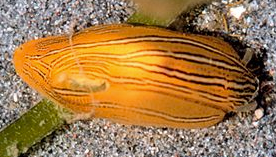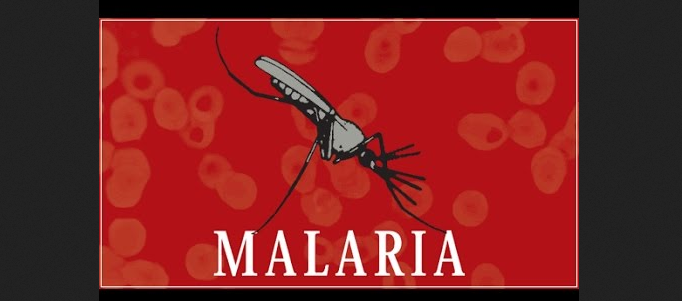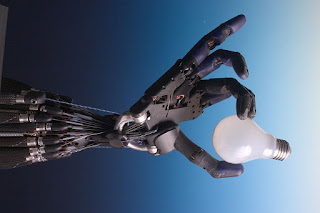Sarah Ferner develops, leads, and teaches education programs for NOAA’s National Estuarine Research Reserve System in San Francisco Bay. As the Reserve’s first Education Coordinator, her job tasks are diverse – ranging from writing for publications and interpretive signs, to teaching teachers about new Next Generation Science Standards, to counting plants deep within Suisun Marsh, and more. Through it all, she likes to traverse the muddy transitions between water and land, and between science and education, following her passion for connecting people to nature through science. She is a certified California Master Naturalist. Previously, Sarah worked closely with the Chesapeake Bay-Virginia NERR as a Graduate Research Fellow where she studied the vegetation community change in a tidal freshwater marsh. Sarah received a B.A. in Biology from Carleton College and an M.Sc. in Marine Science from the Virginia Institute of Marine Science/College of William and Mary, and has over 15 years of experience teaching science to students, community members, and educators.
“When Parasites Kill” – An Interview With Stephanie Rasmussen, M.S.
 |
| Mosquitoes carry malaria (Source: scientistsagainstmalaria.net) |
–>
“Cyborgs! The Not-so-distant Future of Human-Machine Integration” Interview with Dr. Nuria Vendrell-Llopis
 |
| Cyborg (Source: assets4.bigthink.com) |
How did you first become interested in Telecommunications Engineering and Biomedical Science?
Was there a specific time or person that sparked your interests?
“About my job, I like the constant interchange of ideas. I teach to students but I also learn from them. There is always something new, a new discovery, and a new tool. It is very dynamic, tiring sometimes, but never boring. It gets better when you think that your research may be helping thousands and thousands in the future. However, what I like the most about my job and my field in particular is that we are faced with the biggest mystery of our era, like nuclear energy and space discovery were before us. The brain is the new unknown and I would love to be one of those responsible in unraveling its secrets.”
“Please DO! We need young people, and young ideas. Now, my advice would be, go to college, but go to college in Europe or Australia then get your PhD back in the USA. Do internships, try working in industry, come back to academia if you like. Move around, travel the world, engage with people from different cultures. Be open to new ideas, but critic nonetheless. Learn from each small thing and the most important part, never forget to enjoy the trip.”
Name that Bloodsucker! Interview with Eric Engh
 I don’t really have any complaints about my job. I enjoy teaching about entomology, developing curriculum and interactive displays for public events, and I really enjoy being a resource of information for the public. The most difficult part of my job has to do with people who are convinced that some unseen insect is biting/infesting them, but there is no concrete evidence to support this. There are many causes of skin irritation similar to an insect bite that include but are not limited to: environmental sensitivities, allergies, reactions to various chemicals or medications, mental conditions, etc.. These cases can be very difficult because the person is absolutely convinced they have an insect infestation, and they often have already been turned away by doctors, family members etc., and are extremely frustrated. I can identify insects, but in these cases there is little I can do to help, and resources available for people with these problems are scarce.
I don’t really have any complaints about my job. I enjoy teaching about entomology, developing curriculum and interactive displays for public events, and I really enjoy being a resource of information for the public. The most difficult part of my job has to do with people who are convinced that some unseen insect is biting/infesting them, but there is no concrete evidence to support this. There are many causes of skin irritation similar to an insect bite that include but are not limited to: environmental sensitivities, allergies, reactions to various chemicals or medications, mental conditions, etc.. These cases can be very difficult because the person is absolutely convinced they have an insect infestation, and they often have already been turned away by doctors, family members etc., and are extremely frustrated. I can identify insects, but in these cases there is little I can do to help, and resources available for people with these problems are scarce.Cyborgs! This Wed. 10/4 at Marin Science Seminar
Cyborgs!
Integrative Biology – An Interview with Richelle Tanner
Richelle Tanner, a PhD Candidate in UC Berkeley’s Department of Integrative Biology, is bringing her extensive knowledge of how climate change affects neural plasticity and growth within the Eelgrass Sea Hare to Marin Science Seminar on SEPTEMBER 27th, 2017. Details here.
 |
| Eelgrass Sea Hare (Source: NOAA.gov) |
Richelle Tanner is happy to answer any specific questions about how to become a scientist at: rtanner@berkeley.edu. Join us Wednesday, September 27th, 2017 at Marin Science Seminar.
Sea Hares, Cyborgs, Mosquitoes & More! Fall ’17 Marin Science Seminar Calendar is here
All sessions are free, geared towards teenage students (but open to all), and take place Wednesday evenings from 7:30 – 8:30 pm at Terra Linda High School (320 Nova Albion, San Rafael), Room 207. Details can be found at http://www.
SEPTEMBER
27: “Not Your Mother’s Genes: How Maternal and Developmental Plasticity Shift Climate Change Responses in the Eelgrass Sea Hare” with Richelle Tanner of UC Berkeley
OCTOBER
4: “Cyborgs! The Not-so-distant Future of Human-Machine Integration” with Nuria Vendrell-Llopis of UC Berkeley’s Brain-Machine Interface Systems Laboratory
11: “Name that Bloodsucker!” with Eric Engh of Marin-Sonoma Mosquito Vector
18: “When Parasites Kill: Changing Antimalarial Drug Sensitivities in Uganda” with Stephanie Rasmussen of Dominican University & UCSF
NOVEMBER
8: “Flooded by Science and Seawater: King Tides and What they Can Tell us about Sea Level Rise at China Camp State Park” with Sarah Ferner of San Francisco Bay National Estuarine Research Reserve – a program of NOAA and SF State University
15: “Making Faces: Developmental Mechanisms of Craniofacial Evolution” with Richard Schneider of UCSF
Videography Internships Available for Fall 2017
 |
| Medical Simulation at Marin Science Seminar |
Explore science and technology, meet amazing scientists and medical professionals, gain experience for your resume and college applications, develop a portfolio! Our past interns are now students at or graduates of Cal Poly San Luis Obispo, CalTech, Chico State, Harvard, Humboldt State, MIT, Northwestern, Scripps College, Seattle University, Sonoma State, UC Berkeley, UC Davis, UC Irvine, UC Santa Barbara, and UC Santa Cruz.
Marin Science Seminar interns attend and assist with a minimum of 6 science seminars per academic year (there are 12 per year) during which they meet the speakers and assist with various logistical duties. Sessions take place on Wednesday evenings at Terra Linda High School in San Rafael (320 Nova Albion, Room 207) during the school year. Interns arrive the evening of a session at 7 pm and are free to leave once breakdown is completed (between 8:30 and 9 pm).
Videography interns record sessions, edit and upload session recordings, and create teaser videos for upcoming events.
Interns may also research and create materials about event topics, create and distribute outreach materials, and engage in social networking and online development of Marin Science Seminar’s mission to attract more students to the fields of science, technology and math. Training is provided for some intern tasks.
Our internships are also offered in conjunction with the Marin County School to Career (StC) Partnership. Students attending a public high school in Marin County may apply for StC credit. Complete and submit a S2C internship application to your school’s School-to-Career representative or visit them for the complete packet. About the Marin County School-to-Career Partnership
| Marin Science Seminar Videography internship |
| Attend and assist at MSS sessions, 6 Wednesday evenings per semester, 7 – 9 pm |
| At Terra Linda High School, 320 Nova Albion, San Rafael, Room 207 |
| Submit 2 video samples |
| Able to edit video using video editing software |
| Facebook account |
| Recording equipment and SC cards provided |
Apply Online Here
Mathematical Models Help Tell the Future of Animals That Are Living in the Ocean
Scientists, including graduate students, researchers, and post-docs in the life sciences and mathematics, often use mathematical models. A mathematical model is a complex model that represents relationships in mathematical form that is used to study the behavior of a certain organism to make reasonable conclusions. Mathematical models can solve problems relating to biology and many other fields.
 |
| Scientists, such as Alma Yesenia Ceja who is speaking at the next seminar, studies and will talk about what data she finds through mathematical models about the future lives of crabs. |
Interview with Marine Biologist/Veterinarian Claire Simeone of Marine Mammal Center
 |
| Claire Simeone DVM at work |
Claire Simeone, DVM is a Conservation Medicine Veterinarian at The Marine Mammal Center in Sausalito, California, as well as National Marine Fisheries Service in Washington, DC. In addition to taking care of sick marine mammals that come for treatment at the rehabilitation center, she also travels nationally to respond to Unusual Mortality Events, develops international training programs, and works on the Marine Mammal Health Map, which provides a centralized reporting system for marine mammal health data.
To learn more about her profession, we interviewed her.
1. How did you first get involved in marine biology and the field of veterinary?
2. How was your experience training with SeaWorld San Diego?
Much of what I was taught about marine mammal medicine came from my mentors at SeaWorld San Diego and the Navy Marine Mammal Program.SeaWorld has been in the media spotlight recently, and there are a variety of opinions about marine mammals in captive care. In my experience, the animals receive the highest quality medical care, and each person that works with them is incredibly invested in caring for these animals in the best way possible. Medicine is continually advancing, and one of the best parts of my job is that I get to be a part of the pioneering science that improves the health of marine mammals everywhere.
3. What is your favorite “project” you have worked on within the Marine Mammal Center?
One of the most exciting projects has been to be a part of Ke Kai Ola, our hospital for endangered Hawaiian monk seals. We work with partners like the National Marine Fisheries Service and the Coast Guard to rescue young animals that would otherwise not survive on their own, and rehabilitate them in our hospital. We use the knowledge we’ve gathered over 40 years of caring for other seals like elephant seals and harbor seals, and apply it to working with this rare species. Since our hospital opened in 2014, we have rehabilitated more than 1% of the entire population. The best news is that during their last estimate, it looks like the population is starting to increase! This is an amazing way for me to be a part of a project that is literally saving a species.
4. What are the best parts of your job? What are the worst?
There are so many amazing parts of this job! First, every day is different. I never know if I’ll be performing surgery in the hospital, or presenting at a scientific conference, or examining a healthy seal in the wilds of Alaska.
Second, I’m lucky to be able to work with such interesting animals. In addition to being entertaining characters, they’re always teaching us something new about themselves, or the ocean. Third, I love being able to share our science and discoveries with the world. So many of the things my fellow scientists are working on are fascinating, and I am thankful that I’m in a position to share this with so many people.The most difficult part of my job is dealing with the realities of working with sick animals and a sick ocean. We can’t save every animal, and sometimes working with so many sick animals can be sad and overwhelming. That’s why I work to balance negativity with positive conservation stories.
5. Why are you so passionate about ocean conservation?
As we become a global society, our Earth is becoming a smaller place. It used to feel as though our oceans were limitless, with unending stocks of fish. We are now acutely aware that we humans have a significant impact on the ocean. Many of the patients we see at The Marine Mammal Center are impacted by human actions – entangled in ocean trash or struck by a ship.But just as we have the capacity to have a negative impact, we also have the capacity to save our oceans. Marine mammals hold secrets about human health, and the health of the ocean. I feel a responsibility to share these secrets so that every person has the information they need to conserve this planet we share.
6. What advice would you give to someone who aspires to work in a similar field?
It’s a big job to save the ocean! We need lots of people working hard on many different projects. My biggest advice would be to stay open-minded about possibilities. I knew I loved biology, but it was a Spanish teacher who suggested I do an exchange during high school, and now I use Spanish when I work on international marine mammal projects. You never know how your skills will come in handy in the future. Get out there and volunteer at places that are doing interesting work. The Marine Mammal Center has a Youth Crew program for students ages 15-18, and allows you to get hands on experience rehabilitating marine mammals.
Learn more at: http://www.marinemammalcenter.org/Get-Involved/volunteer/youth-crew/
Lean more about Claire Simeone at Marin Science Seminar here: http://www.marinscienceseminar.com/speakers/csimeone.html








